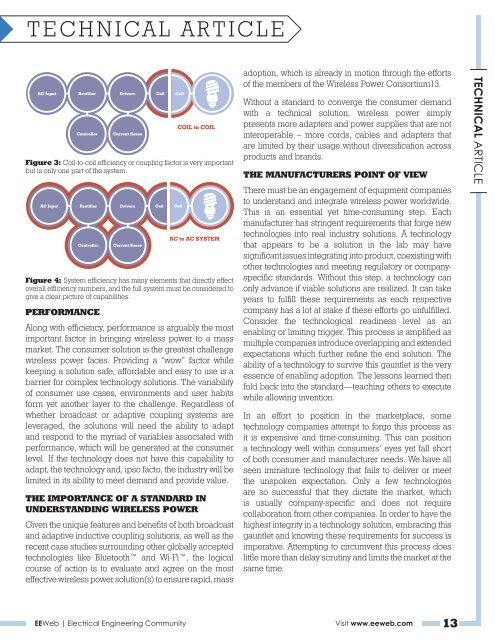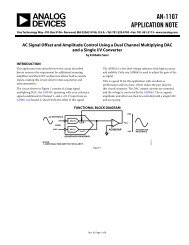Interview with Laurent Desclos - EEWeb
Interview with Laurent Desclos - EEWeb
Interview with Laurent Desclos - EEWeb
You also want an ePaper? Increase the reach of your titles
YUMPU automatically turns print PDFs into web optimized ePapers that Google loves.
TECHNICAL ARTICLE<br />
AC Input<br />
Figure 3: Coil-to-coil efficiency or coupling factor is very important<br />
but is only one part of the system.<br />
AC Input<br />
PERFORMANCE<br />
Rectifier Drivers Coil Coil<br />
Controller<br />
Current Sense<br />
Rectifier Drivers Coil Coil<br />
Controller<br />
Current Sense<br />
COIL to COIL<br />
AC to AC SYSTEM<br />
Figure 4: System efficiency has many elements that directly effect<br />
overall efficiency numbers, and the full system must be considered to<br />
give a clear picture of capabilities.<br />
Along <strong>with</strong> efficiency, performance is arguably the most<br />
important factor in bringing wireless power to a mass<br />
market. The consumer solution is the greatest challenge<br />
wireless power faces. Providing a “wow” factor while<br />
keeping a solution safe, affordable and easy to use is a<br />
barrier for complex technology solutions. The variability<br />
of consumer use cases, environments and user habits<br />
form yet another layer to the challenge. Regardless of<br />
whether broadcast or adaptive coupling systems are<br />
leveraged, the solutions will need the ability to adapt<br />
and respond to the myriad of variables associated <strong>with</strong><br />
performance, which will be generated at the consumer<br />
level. If the technology does not have this capability to<br />
adapt, the technology and, ipso facto, the industry will be<br />
limited in its ability to meet demand and provide value.<br />
THE IMPORTANCE OF A STANDARD IN<br />
UNDERSTANDING WIRELESS POWER<br />
Given the unique features and benefits of both broadcast<br />
and adaptive inductive coupling solutions, as well as the<br />
recent case studies surrounding other globally accepted<br />
technologies like Bluetooth and Wi-Fi, the logical<br />
course of action is to evaluate and agree on the most<br />
effective wireless power solution(s) to ensure rapid, mass<br />
adoption, which is already in motion through the efforts<br />
of the members of the Wireless Power Consortium13.<br />
Without a standard to converge the consumer demand<br />
<strong>with</strong> a technical solution, wireless power simply<br />
presents more adapters and power supplies that are not<br />
interoperable – more cords, cables and adapters that<br />
are limited by their usage <strong>with</strong>out diversification across<br />
products and brands.<br />
THE MANUFACTURERS POINT OF VIEW<br />
There must be an engagement of equipment companies<br />
to understand and integrate wireless power worldwide.<br />
This is an essential yet time-consuming step. Each<br />
manufacturer has stringent requirements that forge new<br />
technologies into real industry solutions. A technology<br />
that appears to be a solution in the lab may have<br />
significant issues integrating into product, coexisting <strong>with</strong><br />
other technologies and meeting regulatory or companyspecific<br />
standards. Without this step, a technology can<br />
only advance if viable solutions are realized. It can take<br />
years to fulfill these requirements as each respective<br />
company has a lot at stake if these efforts go unfulfilled.<br />
Consider the technological readiness level as an<br />
enabling or limiting trigger. This process is amplified as<br />
multiple companies introduce overlapping and extended<br />
expectations which further refine the end solution. The<br />
ability of a technology to survive this gauntlet is the very<br />
essence of enabling adoption. The lessons learned then<br />
fold back into the standard—teaching others to execute<br />
while allowing invention.<br />
In an effort to position in the marketplace, some<br />
technology companies attempt to forgo this process as<br />
it is expensive and time-consuming. This can position<br />
a technology well <strong>with</strong>in consumers’ eyes yet fall short<br />
of both consumer and manufacturer needs. We have all<br />
seen immature technology that fails to deliver or meet<br />
the unspoken expectation. Only a few technologies<br />
are so successful that they dictate the market, which<br />
is usually company-specific and does not require<br />
collaboration from other companies. In order to have the<br />
highest integrity in a technology solution, embracing this<br />
gauntlet and knowing these requirements for success is<br />
imperative. Attempting to circumvent this process does<br />
little more than delay scrutiny and limits the market at the<br />
same time.<br />
<strong>EEWeb</strong> | Electrical Engineering Community Visit www.eeweb.com 13<br />
TECHNICAL ARTICLE















